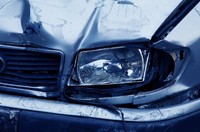Why rear-end car collisions are so common

Rear-end collisions are some of the most common car accidents on the roads. There are many reasons rear-end collisions happen, but one major reason is that rear-view mirrors give drivers a distorted view of what's behind them.
Rear-end collisions make up about 20% of all car crashes, and 70% of those involve no injuries. Rear-enders have the highest injury rates, but they also have the lowest death rates. They often cause more damage to vehicles and property than other types of accidents, but in terms of personal injury, these crashes are usually less severe on average. Why do rear-end car collisions occur? Drivers who get too close to the vehicle behind them or tailgate may be at risk of rear-ending another vehicle.
Driver Distraction
Driver fatigue and distraction often lead to rear-end collisions. The National Highway Traffic Safety Administration (NHTSA) estimates that one in four crashes involve driver distraction, with cell phone use among the top sources of distractions.
Driving while fatigued can result in accidents because of inattention and failure in judgment. You can easily cause an accident because you fail to respond quickly while on the road.
Those drivers who are texting or playing games on their phones may not be able to respond quickly enough when traffic slows down or stops.
Driver error rear end collisions often happen when a driver forgets to stop at a red light or makes a left turn on red and is hit by the driver coming from behind them.
Drivers who are distracted may also not realize how close they're getting to other cars until it's too late. This puts them at risk of rear-ending another vehicle.
Following Too Closely
Rear-end collisions can also happen to drivers who are following too closely.
The rear car is often the one that suffers most in rear-ender accidents because it doesn't have enough space when a collision happens. The force of the other vehicle going through their back end causes whiplash and other injuries more likely from front impacts, such as broken bones and neck injuries. Rear-enders often cause more damage to vehicles and property than other types of accidents, but in terms of personal injury, these crashes are usually less severe on average.
Driving Too Fast for Conditions
Drivers who are driving too fast for the conditions may also be more likely to rear-end another vehicle. Driving on icy roads, standing water, and heavy rain can cause accidents if the driver fails to account for them.
If drivers can't stop on time because of poor traction from rain, snow, or ice, they're at risk of rear-ending another car that's going slower than them.
While it’s true that rear-end collisions are likely to cause minor fender-benders, you can suffer serious injuries too. Whiplash, traumatic brain injury, neck, and spinal injuries can all be caused by rear-end accidents.
How Can You Avoid Rear-End Collisions?
It may be very difficult to stop a rear-end accident. However, by taking certain precautions, you may avoid hitting another vehicle from the back.
You can avoid rear-end accidents by paying attention, avoid driving while drunk, drive carefully in inclement weather, pull over if you need to use your phone, and try as much as possible to concentrate while driving.
Rear-end collisions are a common occurrence on the road, but there are many ways to be proactive in preventing them. If you’re speeding for conditions or following too closely - slow down and give yourself some space! And if you're distracted by your phone or other devices while driving - put it away before getting behind the wheel. The more aware we all can become of our surroundings when driving, the safer everyone will be on the roads.

